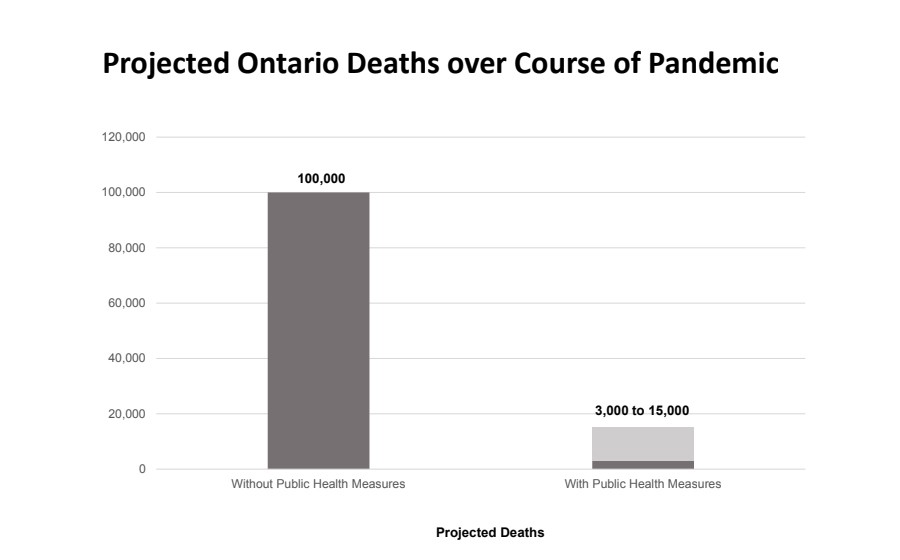
Are Ontario’s measures enough to save thousands of lives the province knows will be lost if COVID-19 response is too weak?
“I hope not,” responded Premier Doug Ford, looking visibly distressed after revealing to 14.5 million Ontarians the crippling reality hurtling down on this province.
He was asked if he will have to introduce even more extreme measures to save thousands of lives across Ontario, after detailing further restrictions that will go into effect midnight Saturday.
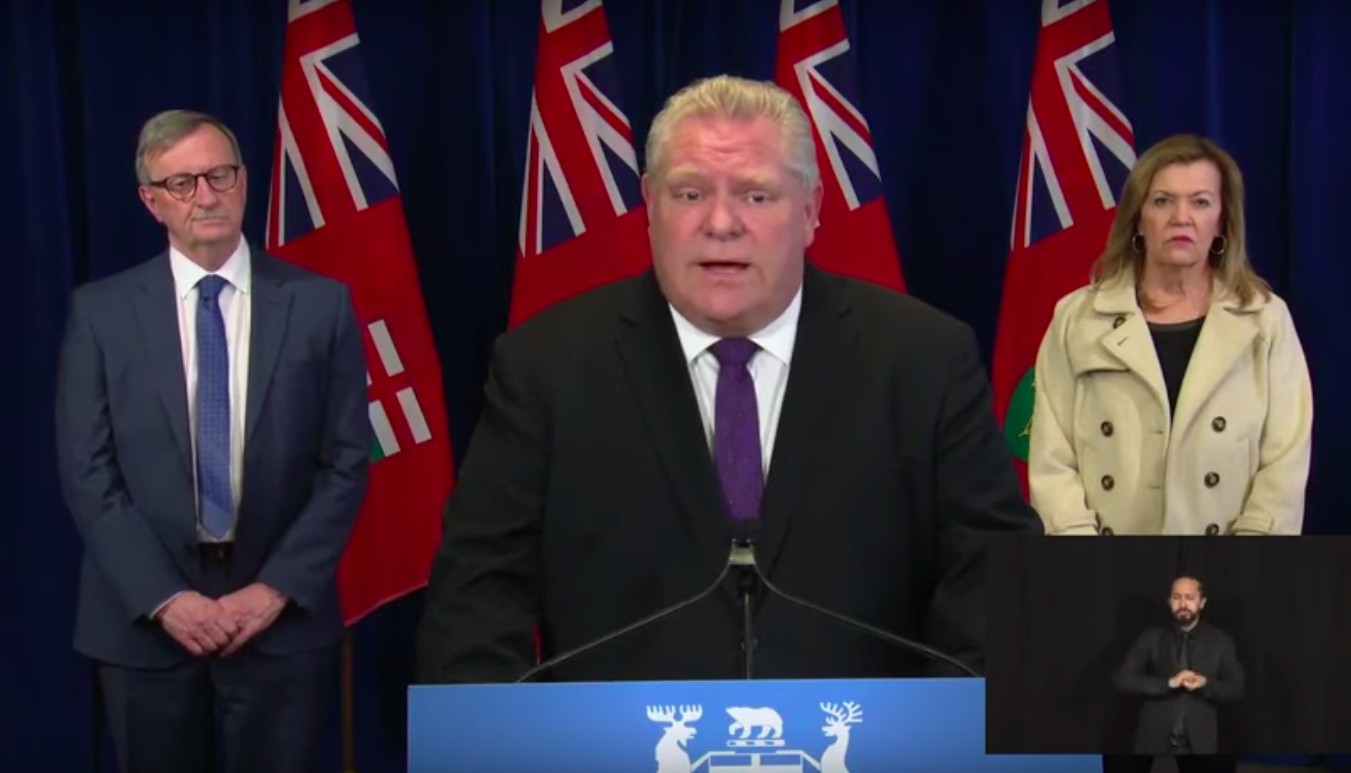
During a Friday press conference, Premier Doug Ford discussed the shocking details of the province's modelling and projections for cases of COVID-19 and related deaths.
Many across the province looked on inside their homes, watching his Friday afternoon press conference, when the alarming numbers were released.
If the province takes no further steps to curb the spread of COVID-19, 1,600 people could die and there could be 80,000 confirmed cases of the novel coronavirus in Ontario by the end of the month.
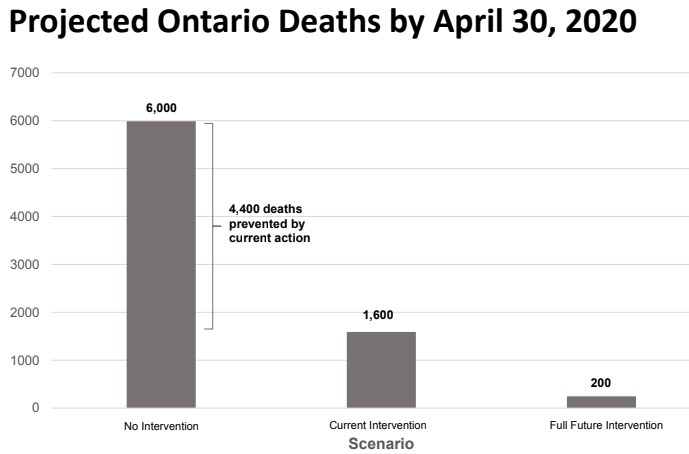
The harrowing news came from Queen’s Park, where Ford detailed the latest measures to slow the spread of COVID-19, after a senior health official presented haunting projections and modelling showing the worst case scenario for Ontario if further action isn’t taken.
Wearing a pained expression on his face, Ford made a desperate plea to Ontarians to consider the impacts of their decisions on the general population.
“We all have to ask ourselves, what is the cost of a life? Is a life worth a picnic in the park? Is a life worth going to the beach? Is a life worth having a cold one with your buddies in the basement? And the answer is no.”
He continued to implore Ontarians. “None of those things is worth as much as a life, so to everyone in Ontario, we need to listen, we need to listen to what the battle tells us. We need to take action, we must take these warnings seriously,” he demanded. “I can’t stress this enough, this situation is extremely serious and we must recognize that the numbers also show that everything we’ve done so far, everything we’ve done together since this started, is working.”
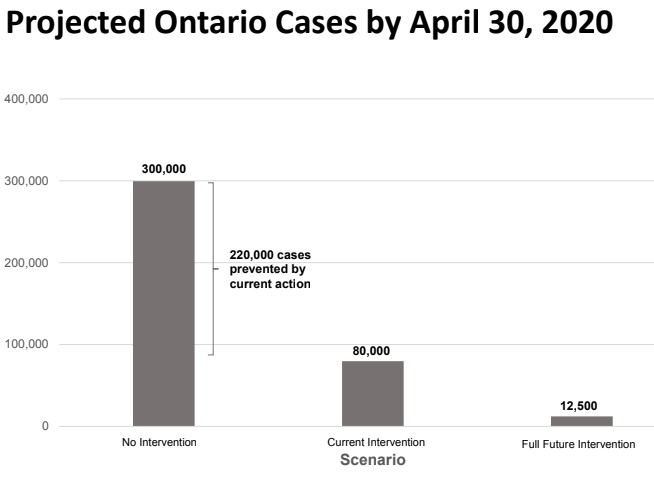
Without the social and physical distancing measures the province has taken to date, the pandemic, which may last 18 months, would have possibly infected 300,000 people by the end of the month, according to the modelling. Fortunately, with the closure of non-essential businesses, among other measures, 220,000 of those projected cases will be avoided.
At the Friday press conference, Ford was joined by government and health officials who together presented the modelling and projections, alongside stricter measures to raise public awareness and ramp up actions to curb the spread of COVID-19.
Were the province to enact “full future intervention,” the number of COVID-19 cases could be kept to 12,500 by the end of April, and deaths could be limited to 200 by the end of the month.
The reduction of 67,500 cases by the end of the month, if more serious restrictions are implemented, would likely be the difference between many hospitals being completely overrun and allowing them to manage the pandemic.
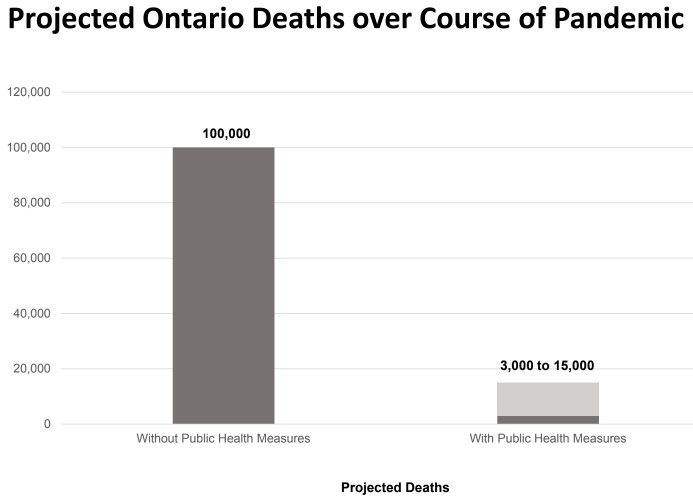
With the revelation on Friday that critical care beds are about to be full in many hospitals (in some cases within a week), with little ability to meet the coming surge for acute care, including the desperate need for ventilators to save lives, the message was clear.
Harsher restrictions will save thousands of lives.
Even with public health measures, Ontario projects between 3,000 and 15,000 people could die over the next year and a half from COVID-19. The province could see a second wave of cases if stricter measures aren’t enforced, said Dr. Peter Donnelley at the Friday press conference. “There is a range because where we end up depends on all of us. If we follow the rules, if we do our best to socially distance, if we look after the elderly and the vulnerable in our society, we can get within that range and we can strive to get as low as possible within that range,” said Dr. Donnelley, president and CEO of Public Health Ontario.
“The numbers released today are sobering,” said Ontario Minister of Health Christine Elliott, who was also at the press conference. “Critically, they reveal a disastrous path now avoided. They also serve as a call to arms for greater action. This is not time for complacency, we must remain vigilant. We’ve been preparing for this very moment for months now but we cannot do this alone. We are relying on every single Ontarian to join us in this battle. Please stay home.”
If everyone doesn’t play their part, says Matt Anderson, CEO of Ontario Health, the virus will continue to spread and put a strain on the province’s healthcare systems. The healthcare systems of Mississauga and Brampton were struggling well before the outbreak of COVID-19 and further strain could have disastrous consequences.
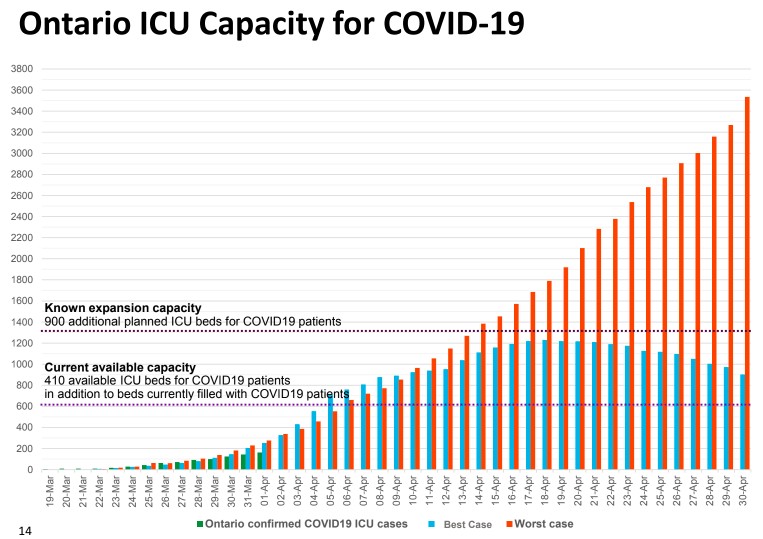
Currently, there are 410 available ICU beds across the province for COVID-19 patients, in addition to those currently filled, Anderson said. This capacity will likely be completely filled in a week, while 900 additional ICU beds are being planned for COVID-19 patients. In the best case scenario, only an average of 1,200 ICU beds will be needed, according to the data. In the worst case scenario, where people don't practice physical distancing and strict measures aren’t followed, around 3,500 ICU beds will be needed.
“We are trying everything we can to continue to increase the capacity that we have to respond to this disease. However, as you've already heard, we need everyone to play their part. We have to try to keep the prevalence of this disease to a minimum to allow our healthcare system to be able to support those who need it,” Anderson said.
The data presented is not localized but represents a collective number of ICU beds available in Ontario. Without localized data, it’s hard to know which hospitals are struggling as rates of COVID-19 spike in some municipalities and cities across the province but not others.
Peel’s healthcare systems were struggling long before the first case of COVID-19 was reported in Canada. In Brampton, the city’s only hospital capable of treating COVID-19 patients, Brampton Civic, operated above 100 percent capacity throughout 2019. The hospital is operated by the William Osler Health System, which also runs Peel Memorial Health Centre in Brampton and Etobicoke General Hospital in Toronto. Its 2019-2024 roadmap describes an “unrelenting pressure” on the hospital network, which led to more than 150 days of “code gridlock” in 2018. Two years ago, the numbers of patients needing treatment far outweighed the number of beds available for more than 40 percent of the year. Since then, as Brampton’s population has continued to grow, this pressure has only gotten stronger.
In an email, Osler told The Pointer efforts have been taken to extend critical care capacity at Brampton Civic and Etobicoke General. “These efforts include moving non-critical care patients to different areas of the hospital and actively pursuing relocation of chronically ventilated patients within Osler, or to chronic ventilator facilities in the community,” an email from the health network reads. While Osler mentioned it did have the capacity to care for COVID-19 patients, including those who require the help of a ventilator, it’s not clear how many of these patients can be treated at Brampton Civic. Currently, there are 23 COVID-19 patients being cared for in Osler’s hospitals. “Osler has not yet had to access a provincial stockpile of ventilators, which has recently been approved to increase in number,” the health system said.
Trillium Health Partners (THP) operates Credit Valley Hospital and Mississauga Hospital in Mississauga. In its 2019-2020 plan, the network described its current setup as “under-resourced for the size and needs of the community.” While the province’s target time for patients to be admitted from the emergency room is eight hours, a standard that is met for 33 percent of patients, the average time is 21.2 hours at Mississauga Hospital, even longer than Brampton Civic, ranking it 100 out of 113 hospitals included in the data. Meanwhile, only eight of the included hospitals have worse averages than 105th placed Credit Valley Hospital, where patients wait for an average of 23.7 hours. On Tuesday, Credit Valley Hospital declared an outbreak after four patients in a single unit were tested positive for COVID-19.
Given the dire situations already plaguing Peel’s healthcare systems before the pandemic, localized data can help hospitals in Brampton and Mississauga know what they’re up against as cases of COVID-19 increase.
If a specific community sees a cluster of outbreaks because of a super-spreader (an individual who transmits the virus to a much larger number of people than most who are contagious), public health officials might eventually pick up on the trend. It’s challenging for community members to know what is happening in their own backyards without localized data.
There are currently 230 cases of COVID-19 in Mississauga, which is 3.06 infections per 10,000 residents, based on a projected Mississauga population of 750,000. Comparatively, with Toronto’s 986 cases, the per capita rate is 3.33 for every 10,000 residents, based on a population of 2.9 million. These numbers suggest the prevalence of the virus amongst Mississauga’s population is similar to Toronto’s population. Localized data like this can assist struggling healthcare systems in planning ahead.
The stricter measures discussed during Friday’s press conference do not include a complete lockdown of the province. Instead, the list of essential workplaces was shortened by 30 from 74 to 44. The province is focusing on fines for people who do not practice physical distancing and non-essential businesses that stay open.
The province's projections are based on measures currently in place, many of which have only been in place for the last two weeks. On March 12, it was announced all public schools will close down. The next day, gatherings of more than 250 people were banned and personal visits to correctional facilities came to an end.
On March 17, the provincial government declared a state of emergency in Ontario. At that point, there were already 79 confirmed cases of COVID-19. The emergency closed down public libraries, theaters and limited restaurants to only serving take out. On March 23, all non-essential businesses were ordered to close. But the list of essential services was quite large, including 74 different sectors, raising questions if the measures actually kept more people at home.
Last week, the province mandated the closure of all parks and outdoor recreational amenities while self-isolation was strongly advised for people aged 70 and older recommended for people over 70 and those with a compromised immune system. Violators caught breaking the rules would be charged anywhere from $750 to $100,000.
“When we take a step back, we can fully grasp what fighting this terrible virus has cost us. What it has cost us as a province and as people. We’ve all had to make tremendous sacrifices and none more than our frontline healthcare workers. But everyone has had to pay a price in this war,” Premier Doug Ford said during today’s press conference.
Email: [email protected]
Twitter: @nida_zafar
Tel: 416-890-7643
COVID-19 is impacting all Canadians. At a time when vital public information is needed by everyone, The Pointer has taken down our paywall on all stories relating to the pandemic to ensure every resident of Brampton and Mississauga has access to the facts. For those who are able, we encourage you to consider a subscription. This will help us report on important public interest issues the community needs to know about now more than ever. You can register for a 30-day free trial HERE. Thereafter, The Pointer will charge $10 a month and you can cancel any time right on the website. Thank you.
Submit a correction about this story


